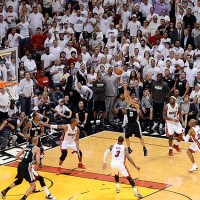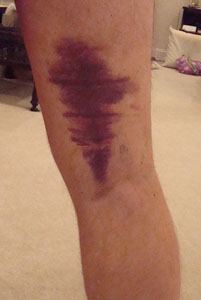Sacre Bleu! Tony Parker’s Hamstring Injury

by Steve Caronia
With just over 5 minutes remaining in the third quarter of Tuesday’s game 3 of the NBA Finals, Tony Parker left the game with an injury. After getting an MRI, Parker was diagnosed with a grade I strain of his hamstring. As he is certainly integral to the Spurs’ success, we must know: can Parker play? If so, can he be effective? What the hell is a strain, anyway?
First, a quick overview of muscle anatomy. Muscles are essentially bundles of fibers grouped together in parallel that are surrounded by connective tissue called fascia (think sausage casing). These fibers are comprised mainly of proteins (actin and myosin) that are able to contract. In other words, the muscle can shorten, pull on a bone, and provide movement. Nerves that connect to muscles give them the input from the brain and spinal cord to do what we want them to do. Muscles have lots of blood – as they need tons of oxygen to provide the energy to move.
(Please note that it is EXCEPTIONALLY more complicated than that. But don’t sweat it right now)
Often, muscles get injured. We call them “pulls” much of the time, but what we’re really referring to is various degrees of tearing withing the belly of the muscle. This is called a “strain” in fancy pants talk. Strains typically occur when a muscle is trying to elongate and fire at the same time very quickly (I spoke about this in the Kobe Bryant Achilles article; similar principles apply to tendon and muscle belly). Strains are classified by how much the muscle is torn. Grade I means there is either over stretching of the muscle or minor tearing, no more than 25%. Grade II refers to a larger tear, about 25-50%. This tear is a lot more debilitating and usually results in a pretty black and blue up and down the back of the leg in the hamstring’s case. Grade III is even more severe, with the majority of the fibers being torn. Sometimes even a complete rupture will occur, usually requiring surgery.
So Parker is lucky in that the strain is merely a grade I. Unfortunately, hamstring strains are quite annoying. If you’ve ever had one, you know that the pain and tightness can linger for weeks on end, especially without appropriate rest. You’ll see players hobbled on the court or field for months sometimes, as they play through the pain but it never fully disappears. Such rest is very difficult as the hamstrings are used with every step we take. It’s main function during walking and running is to decelerate the leg while it is propelled forward. The hamstring lengthens as it slows your leg down so your foot can hit the ground. So as the muscle is trying to mend, simple walking can repeat the same type of movement that got it hurt in the first place. In addition, your hamstring stabilizes your hip when your leg is on the ground. Basically, unless you lie around in bed or learn to levitate, your irritating the injury. It’s like trying to glue two things together and pulling them apart every 5 seconds saying “Is this dry yet? No, ok I’ll check again.”
I fully anticipate Parker to play in game 4, and if the strain is really minor he might be ok (last I heard it was only stretched, not torn at all). But don’t be shocked if he’s a little ginger on that leg. Trainers are going to be controlling inflammation, keeping soft tissue flexible, and making sure the muscle doesn’t tighten up. He’ll probably be on a stationary bike of stretching every single second he’s not in the game. This will keep blood and neural output flowing and the muscle will stay flexible.
Time will tell if Tony Parker will be his dynamic self the rest of the series. But if not, we all know Danny Green and Gary Neal can just shoot the lights out every night, right?
Tweet Share


